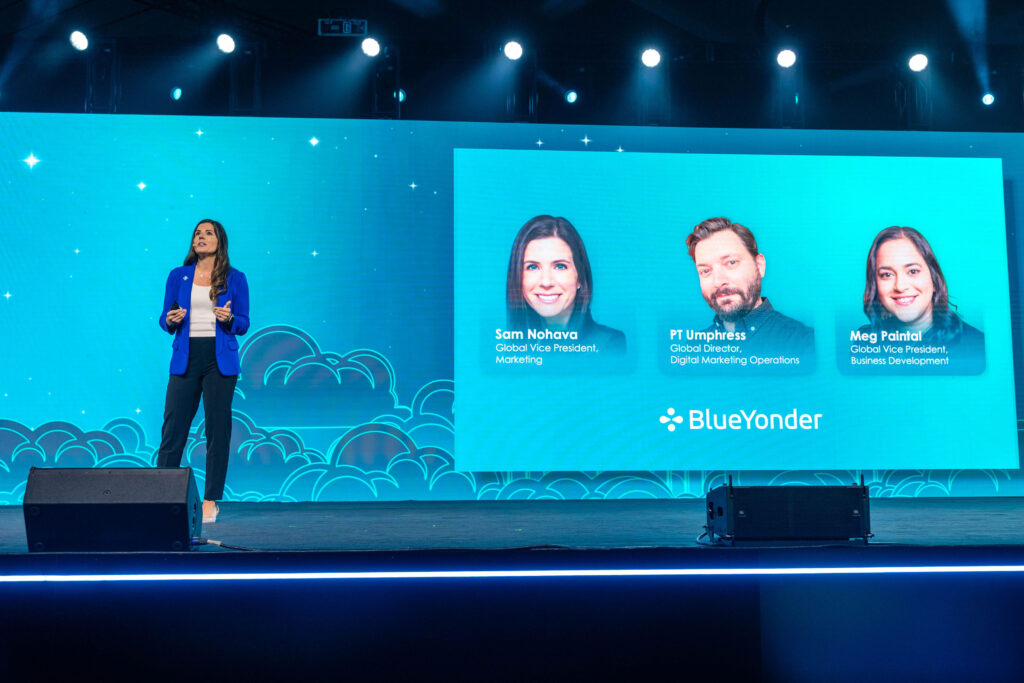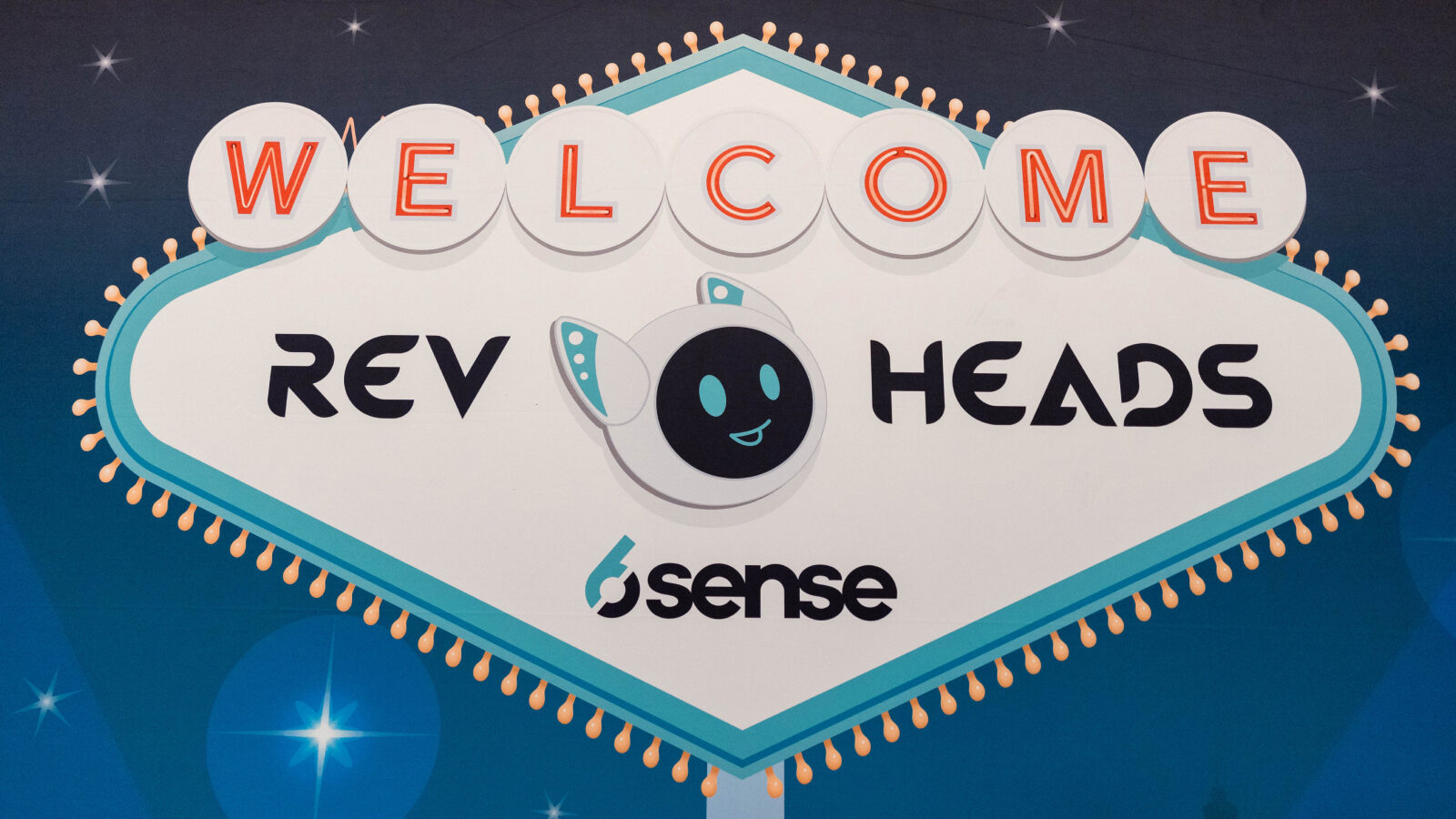And just like that, the second day of Breakthrough is over already! Time flies when you’re having fun networking learning from fellow revenue experts.
The 6sense culture is centered on working hard and playing hard, and today is a perfect example of just that. Right after breakfast, attendees were officially welcomed to Breakthrough with a keynote session from 6sense CEO Jason Zintak (below). Then Viral Bajaria (CTO & Co-Founder), Jerome Levadoux (Chief Product Officer), Latané Conant (CRO) shared 6sense’s product vision.

After a networking break, attendees got to hear a real-life success story from Blue Yonder. After lunch, attendees fueled up on more winning formulas from customers over a dozen sessions tailored to marketers, sellers, and operations.
Here’s a taste of what attendees learned:
How Blue Yonder Leveraged 6sense for Data-Driven Growth and Transformation
Blue Yonder won ABM Program of the Year in 2023, and in this session their revenue team came together to show how they made revenue success less of a gamble by:
- Synchronizing data across previously disparate martech and advertising platforms. (a.k.a. “Doubling down on 6sense and LinkedIn.”)
- Engaging with prospects earlier in the buyer’s journey to deliver relevant messaging, content, and offers. (a.k.a. “Hitting the jackpot of relevancy.”)
- Curating higher quality MQLs to drive revenue teams towards the most efficient path to conversion. (a.k.a. “Know when to hold ’em, know when to fold ’em.”)
- Orchestrating intent across all revenue functions to increase sales and marketing intelligence. (a.k.a. “Reading the room and counting the cards.”)

Blue Yonder’s integrated marketing and sales results have been supercharged by these efforts, resulting in:
- 31% more 6QAs created
- 23% increase in pipeline created
- 42% higher deal values for 6QA wins
Blue Yonder’s Sam Nohava, Global Vice President for Marketing, kicked off the presentation by sharing how the team has continued to advance its ABM program to reach and serve even more manufacturing, logistics, and retail companies in 76 different countries.
PT Umphress, Global Director for Digital Marketing Operations, shared how 6sense data intelligence is tied into various platforms — including LinkedIn, Matomo for analytics, Drift for website chat functionality, Salesloft for sales outreach, and Sendoso for gifting.
6sense’s account data enriches each of these tools, monitors the data generated within these tools, and interprets what’s happening across the entire buyer journey.
“6sense is the whole brain connecting to all parts of this technological nervous system,” he said.
Major advancements over the past year have included:
- Using 6sense dynamic segments to power always-on advertising. “This allows us to launch the entire scope of a multi-stage campaign at once, dynamically aligning the right content and messaging to the customer journey without manual intervention,” Sam says.
- An increased focus on early stage buying engagement so Blue Yonder can get ahead of buying cycles and drive preference with truly dynamic, scalable strategies.
- Moving away from gated content so that potential customers can enjoy frictionless research — and be influenced along the way!
Another Big Change: A New Approach to Outbound Sales
Meg Paintal, Global Vice President for Business Development, said the sales team now focuses less on the actions of individual MQLs, and more on the overall level of activity within an account. This includes strategic outreach to engage multiple buying personas within accounts that are showing interest, since engaging more of the buying team increases the odds of closing a deal.
The sales team is also focusing much more on 6QAs — accounts that 6sense has flagged as likely buyers thanks to behavioral signals and ICP fit. Meg says 6QAs are now treated with the same urgency as inbound leads.

Sales Track Highlight
Intentional Outbound: Managing Reps for Success in a Signal-Led World
The Account Development team at CloudZero were big fans of 6sense, but despite covering all of their high intent accounts with multi-channel outbound efforts, they weren’t generating nearly enough pipeline.
This session was an open look into why initial efforts weren’t working, and what they did to fix it.
The sales leadership team decided to get more prescriptive in order to drive repeatable outbound pipeline. They called it their “Intentional Outbound Era” — and they used as many Taylor Swift memes in their rollout (and their session presentation) as they possibly could.
Diagnosing the problem turned up:
- Missed opportunities
- Reps only using a fraction of 6sense intent data
- Inefficiencies in working 6QAs, such as a failure to multithread opportunities
- Discrepancies in messaging
The solution? CloudZero took action to:
- Redefine 6QAs
- Sift through intent account data to identify why customers need their solution
- Document the exact steps reps should take
- Prescribe outreach effort based on intent
- Focus reps on revisiting 6QAs
- Maintain consistent 1:1s with reps to reinforce skills and accountability
“When we realized there was no standard effective process for research prospecting and messaging across the team, we decided on what good should look like and documented the exact steps we wanted our reps taking from research all the way down to messaging,” shared Kelsey Cowher, Director of Account Development for CloudZero,
The more disciplined approach yielded:
- 33% more opportunities
- 27% more pipeline value
Way to go, CloudZero, and thanks for sharing your lessons!
Marketing Track Highlight
Back to Basics: 3 Crucial Components of a Sticky ABX Program
Benjamin Cope, ABM Lead at Recorded Future, said the success of your ABX program hinges on its integration into the fabric of your overall revenue strategy, with three key components:
- Calculating the true value of key accounts
- Tiering accounts accordingly
- Accurately measuring success in a way that won’t set you up for failure
1. Understanding the Value of Each Account
Cope pointed out that the opportunities you get from ABX campaigns will likely be more expensive than a traditional MQL cost-per-lead — but also much more valuable.
That’s why understanding the value of accounts early on is so important. Marketing budgets and resources can be allocated effectively based on the predicted revenue.
Account value is determined by multiple factors, including business metrics, revenue metrics, and 6sense metrics such as 6QAs, that make it possible to predict ICP fit, opportunity value and cost, and expected win rate.
2. Tiering Accounts by Value
Getting granular with account tiering makes ABX even more effective, and further helps with resource management. Select a handful of must-win accounts that will receive 1:1 marketing — a big investment anticipating an even bigger reward. The second tier should include accounts that match focused segments and can be reached through segment-specific marketing campaigns.
The rest of your ICP accounts sit in the final but still very important tier. These accounts still get targeted outreach from your BDRs, but you can reduce the time and cost needed by using automation, such as Conversational Email.
3. Measuring Revenue Impact, Not Just Marketing Impact
Benjamin explained how the measurement of ABX programs should differ from traditional marketing programs. If you try to measure your account-based sales and marketing impact through the traditional lens, you’re going to be in for a bad time.
It’s not just as simple as an inbound lead becoming an opportunity, then that opportunity becoming a closed-won. The buying journey is messy, made up of multiple components like email campaigns, direct ads, field events, webinars, and other touchpoints, and you have to take all of those metrics into account to determine success.
The most important metric to measure, however, is revenue. Remember: You don’t pay the bills with pipeline.
Operations Track Highlight
Cleaning House: How to Keep Your 6sense Instance Tidy
Cassie McGowan, Director of Marketing Operations of Pantheon Systems, broke out the broom and dustpan — and some MOPs — to talk about essential housekeeping tasks for keeping 6sense clean and running smoothly.
Takeaway: Keyword management is key to cleanliness
One of the significant challenges that Cassie’s team faced was managing “noisy” keywords. These are keywords that are too generic and don’t provide much value in terms of informing the marketing strategy.
To tackle this, her team did a keyword audit to see what keywords they were using, identify and sort out duplicates, and remove keywords that were too similar.
It’s important to keep in mind that to keep a clean house, keyword audits aren’t a one-and-done thing. Keywords should be reviewed and those deemed unnecessary or redundant should be deleted or deactivated on a regular basis.
Takeaway: Use automation to keep sales teams on alert
Another challenge Cassie’s team dealt with was managing alerts for sales teams. As the number of segments increased, so did the number of alerts she needed to manage. To address this issue, the team automated the process, which proved to be a game-changer.
Best practices for automating alerts include:
- Setting up a folder structure in Segments to keep all teams organized
- Simplifying which segments should be used across teams, and which should be set up as individual segments for each sales rep
- Auditing active alerts quarterly
- Setting up “evergreen” alerts for teams
And Now, We Party!








The sessions are over for the day, but the fun goes on with the Sponsor Reception and the CAB Reception and Experience.
Stay tuned for more session recaps and follow our social media to see highlights from our receptions, parties, award events, and other great Breakthrough moments!



